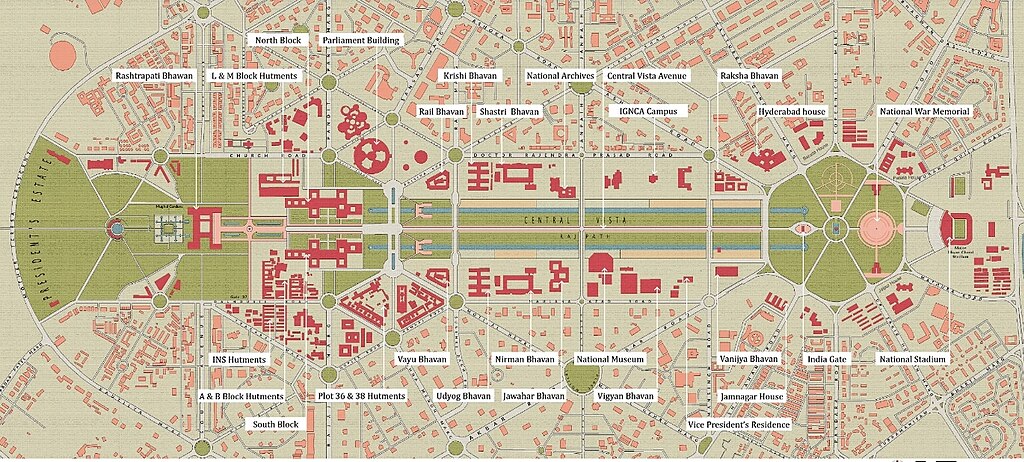Architecture, planning and early development
Sir Edwin Lutyens and Sir Herbert Baker were selected to design the area in a traditional Indian fashion. [2] The architects decided that the area where the foundation stones of Delhi were planted, Coronation Park, was an unsuitable area. [8] They decided the village Malcha on Raisina Hill, as it had a ridge which could quarry stone. [9] Lutyens and Baker toured the country trying to find the key to Indian architecture. They visited Hindu temples, Buddhist stupas, the Taj Mahal, and palaces in Bikaner and Mandi. [2] They came back disappointed and convinced that there was no "Indian style of architecture" and only mushrooming dynasties who built large buildings. [2] They noted that the Indians of old knew how to build grand forts, palaces, mausoleums, tombs and durbar halls but not panchayat houses, legislative assembly buildings, or buildings for commoners. [10] [1]
The duo decided that they would give the buildings a façade of "Indianness", which would include the sunbreaker (chhajja), latticed window (jali) and dome (chhattri), while the rest of the architecture would be almost entirely British in nature. [2] They elected to use stone used by the Mughals from the Vindhya Range, marble from Makrana and Jaipur and both stone and marble from Dholpur. [3] The original Viceregal Lodge was meant to be made in white marble, and Lutyens had wanted the garden to be an English landscape garden rather than a Mughal garden. [11]
Lutyens had made a grand plan for New Delhi, much larger than what had happened. His original plan was to dam the Yamuna behind Humayun's Tomb, create a huge lake and a riverside boulevard around it and enclose the Purana Qila in a reflecting pool. [2] Along with this he wished for the Kingsway to be built from the Viceregal Lodge through India Gate up to the Purana Qila and for another road to be built from the South Block up to the south entrance of the Jama Mosque, Delhi. [2] All these ideas had to be abandoned, the former two because of costs and the latter because the road would have gone through Gurdwara Rakab Ganj and the Sikhs under Sardul Singh Kavishar were already in opposition. [12] The Viceroy became peevish due to the costs of Lutyens' plans, to which Lutyens wrote, "the Viceroy thinks only of the next three years, I am thinking of the next three hundred years." [13]
Originally Lutyens wanted to use the gridiron pattern of city planning as was used in other cities like New York, but the hexagonal pattern was later preferred as it could break up the dust storms that swept the landscape; for that same reason, they included many roundabouts and hedges. [13] Lutyens and Baker were mainly inspired by other capitals like Washington, Canberra and Pretoria. [13] There were three other sites which Lutyens and Baker had selected, east of the Yamuna, north of Shahjahanabad and west of Malcha Mahal. [13] From 1914 to 1926 a temporary capital was built and occupied north of Old Delhi, including the Delhi Assembly Building. [13] While Baker and Lutyens were designing the larger buildings, the connection between New Delhi and Old Delhi was designed by Robert Tor Russell, and named Connaught Place. [13]
The Viceroy, Lutyens and Baker were all in agreement on one idea, that India was going to be independent and they were making the city as the building blocks for the independent India. [2] Although Lutyens and Baker did have disagreements, Lutyens wanted the Viceregal Lodge to be on a higher level than the civil servants' offices, whereas Baker thought that in an independent democratic India the ruler and servants should be on the same level. [2] The King and Viceroy approved of Baker's idea. [2] Another time Lutyens wanted the slope between the Viceregal Lodge and the two secretariats to be at a steeper angle, whereas Baker believed that a gentle incline would be better as it did not matter whether or not a pedestrian could see the lodge. [2] Once again Lutyens was overruled. [2] The duo were not on speaking terms anymore, although New Delhi continued to be built. [2]
During the early stages of modern Delhi's development after the Delhi Durbar, Sujan Singh and Sunder Singh Dhupia were the new capital's main real estate developers, although their work was stopped due to World War I. [14] The foundation stones of Delhi were shifted from the Coronation Park to Raisina Hill by Sobha Singh, the son of Sujan Singh. [2]
This page is based on this
Wikipedia article Text is available under the
CC BY-SA 4.0 license; additional terms may apply.
Images, videos and audio are available under their respective licenses.
